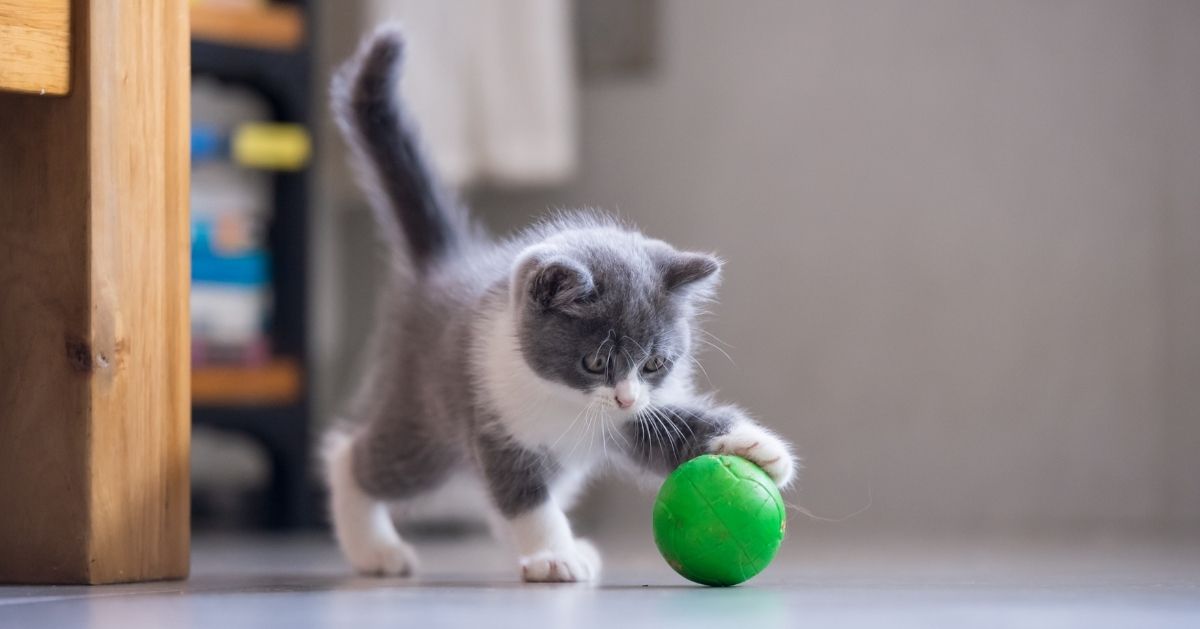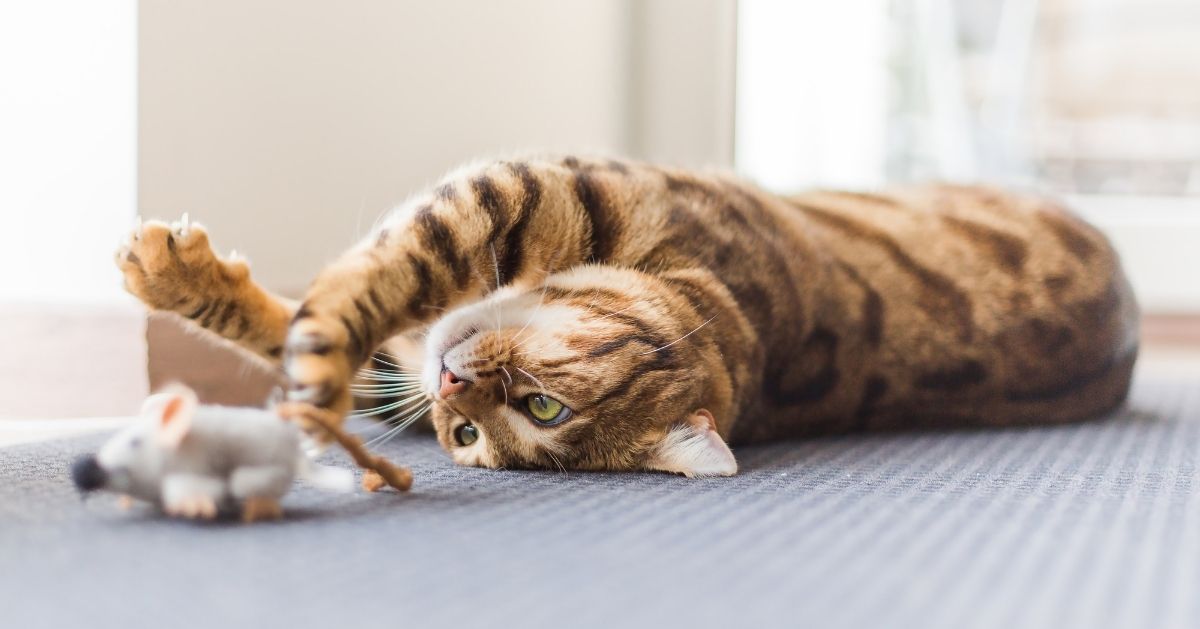How to Exercise Your Cat
There are many reasons why you might decide to keep your cat indoors: perhaps you live in a place with little, or no, outside space, or you simply want to keep them safe from traffic, predators – and other cats too.
Cats can live a perfectly happy and normal life indoors but you need to put everything in place to ensure they are kept both physically and mentally exercised.
If your cat spends a lot of time outside, they often make their own fun chasing leaves or mice, they climb trees and hide behind bushes – but whether your kitty is an indoor or outdoor cat, they still need to have regular playtime to help strengthen your bond and stimulate their senses.
How to Exercise Your Cat
Here are some tips on how to ensure your cat gets plenty of exercise by using their natural instincts:
Pouncing
Get a fishing rod toy that can mimic their prey outside – a homemade one with a small stick, a piece of string and a fluffy feather or toy dangling at the end will be just as good as a shop-bought one. Drag it along the floor slowly, followed by a burst of quick movement. You’ll know when your cat is loving your pouncing game as they will crouch down low, keeping a close eye on their ‘prey’, and then they will give their rear a little wiggle before launching and pouncing on its target.
Make sure you end the game with a little treat or kibble so that they feel rewarded and enjoy the thrill of the catch. Keep the sessions short, perhaps a few times throughout the day; early morning or early evening is a good time for playing – this is when cats are at their most active.
Climbing
When cats are outside, they meander along the top of fences, sheds and trees. These are all enticing for a cat as they are all different heights, textures, places to hide, and places where they can spy without being seen. Giving them access to shelves or tops of cupboards indoors is essential to try and replicate outdoor experiences.
Cat towers are excellent, as they often have elevated spaces for your cat to rest on. You could also get creative with other items around the house, like shelves, boxes, and toys to make your own ‘tree’ that your cat will love!

Chasing
There are some simple games that you can play with your cat to give them a cardiovascular workout – and chasing an object is an obvious one.
- Rolling a ping-pong ball along the floor, or up against a wall so that it bounces back, will be very tempting for your cat to chase.
- A wind-up toy will keep your cat curious and active while they chase it around the floor. Make sure that it has no sharp edges that could harm your cat when they catch it.
- When used properly, playing with laser pointers is a fun cardio activity for your cat. However, be sure to take some safety precautions, otherwise, you could harm your cat’s vision:
- Use a low-wattage light, with a maximum power output of 5 milliwatts.
- Never shine the light directly into your cat's eyes.
- Store the laser toy in a secure spot that your cat can't reach.
- Keep the playtime short, as your cat could get frustrated.
- End the game with the light landing on a reward so that they think they have chased and caught their predator.
Scratching
Scratching is an essential part of a cat’s self-maintenance and it helps keep their claws in good condition. If you want to protect your furniture, you should consider getting a scratching post for your cat!
A scratching post also helps your cat have a good stretch after they have had a snooze – they can grab the post up high with their claws and stretch their full body. Vertical scratching posts commonly use sisal, but an old piece of carpet attached to a sturdy base would also work. Have one or two scratching areas around the home to keep their interest.
Exploring
Cats are curious by nature! How often have you unpacked an item, only to find your cat jumping in and exploring the cardboard box and its contents? It’s important to keep your cat’s inquisitive instincts up to scratch, so adding different items to a box every so often, will help to keep these instincts keen. To give them a feeling of being outside, why not add some twigs or leaves to tickle their whiskers!
Hiding
As well as energetic activities - cats love to hide! It’s a basic instinct that domestic cats still have from their predecessors, so you need to make sure they have plenty of hiding places around the home; under beds, cardboard boxes, open cupboards, behind curtains or gaps behind furniture are all great places that your kitty can retreat to if they feel that they want to escape. Having plenty of accessible hiding spots will help to keep your cat calm, relaxed and feel safe.
However, to avoid any accidents, make sure that doors to washing machines or dryers are kept closed when not in use. They can be very tempting to a curious cat.
It is also common for new cats to go into hiding when they first come into your home. As long as you are confident that there are no open windows or doors where they can escape, be patient, and they will appear again when their curiosity gets the better of them!

Mental Stimulation
Whiskers are part of a cat’s sensory system that sends information to their brain, so exploring a box with lots of different items will also help their mental stimulation.
Setting aside 10-15 minutes during the day for kitty playtime will not only build your bond, but it will provide the mental stimulation your cat needs. Indulge their hunting instincts by hiding some treats or kibble through the house for them to stalk and find, or use a puzzle toy so that they have to work out how to get their favourite treats. Remember not to give too many treats – kibble works just as well.
Training
If you thought that cats couldn’t be trained, think again! Although you may decide to keep your cat indoors most of the time, you will need to take them outdoors on occasions and training them to get into a cat carrier or to come when they are called are all important things your cat should learn. But, training a cat is also fun!
The best time to train your cat is when they are relaxed – FELIWAY CLASSIC is frequently used by cat owners to help their cat remain calm and serene in the home.
Controlled access to the outdoors
If your indoor cat is showing signs of wanting to go outside, perhaps a halfway solution could provide some of the exercise they need. If you have a small garden, or a patio that can be enclosed, consider taking your kitty outside on a harness or lead to let them enjoy some outdoor smells and sounds.
Alternatively, you could install a catio or an escape-proof solution, which can give your cat the best of both worlds and get the exercise they need.
